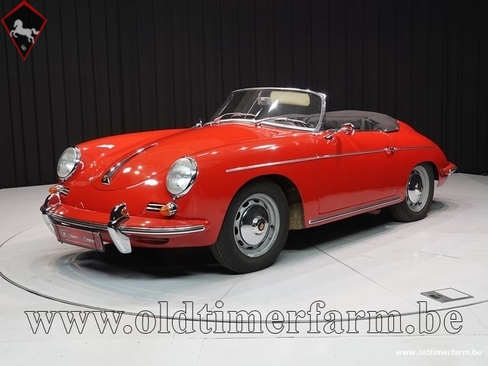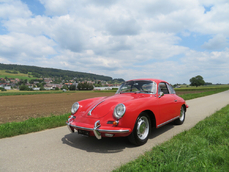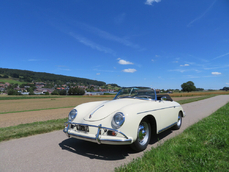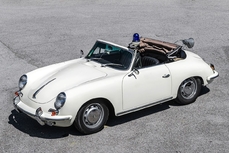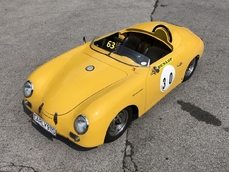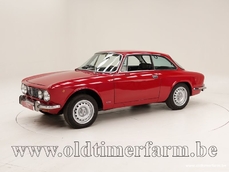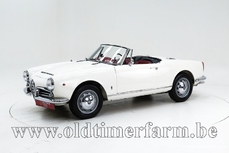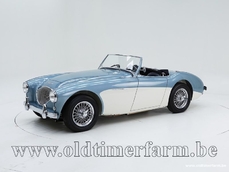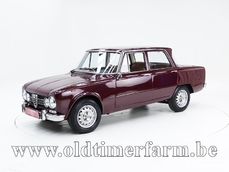Porsche 356 B Roadster '60 1960
Allgemeine Beschreibung :
Prior to World War II Porsche designed and built three Type 64 cars for a 1939 Berlin to Rome race that was cancelled. In 1948 the mid-engine tubular chassis 356 prototype called "No. 1" was completed. This has led to some debate as to the "first" Porsche automobile, but the 356 is considered by Porsche to be its first production model.[1][2] The 356 was created by Ferdinand "Ferry" Porsche (son of Dr. Ing. Ferdinand Porsche, founder of the company). Like its cousin, the Volkswagen Beetle (which Ferdinand Porsche Senior had designed), the 356 was a four-cylinder, air-cooled, rear-engine, rear-wheel-drive car utilizing unitized pan and body construction. While the 356's body was an original design by Porsche employee Erwin Komenda, its mechanicals (including engine, suspension and chassis) were derived from the Volkswagen. The first 356, was roadcertified in Austria on June 8, 1948, and used many Volkswagen parts for manufacturing economy. Porsche quickly re-engineered and refined the car with a focus on performance. By the late '50s many fewer parts were shared in common between Volkswagen and Porsche. The early 356 automobile bodies produced at Gmünd, Austria were handcrafted in aluminum, but when production moved to Zuffenhausen, Germany in 1950, models produced there were steel-bodied. Little noticed at its inception, the first 356s sold primarily in Austria and Germany. From the first prototype in 1948, it took Porsche about two years to manufacture the first 50 automobiles. By the early 1950s the 356 had gained some renown among enthusiasts on both sides of the Atlantic for its aerodynamics, handling, and excellent build quality. It was common for owners to race the car as well as drive it on the street. Increasing success with its racing and road cars brought Porsche orders for over 10,000 units in 1964, and when 356 production ended in 1965 approximately 76,000 had been produced. The basic design of the 356 remained the same throughout its lifespan, with evolutionary, functional improvements rather than yearly superficial styling changes. Nevertheless a variety of models in both coupe and convertible forms were produced from 1948 through 1965. Cabriolets (convertibles) were offered from the start, and in the early 1950s sometimes comprised over 50% of total production. One of the most desirable collector models is the 356 "Speedster", introduced in late 1954 after Max Hoffman, the sole US importer of Porsches, advised the company that a lower-cost, open-top version could sell well in the American market. With its low, raked windshield (which could be removed for weekend racing), bucket seats and minimal folding top, the Speedster was an instant hit, especially in Southern California. Production of the Speedster peaked at 1,171 cars in 1957 and then started to decline. It was replaced in late 1958 by the "Convertible D" model. It featured a taller, more practical windshield, glass side windows and more comfortable seats. The following year the 356B "Roadster" convertible replaced the D model but the sports car market's love affair with top-down motoring was fading; soft-top 356 model sales declined significantly in the early 60s. To distinguish among the major revisions of the model, 356's are generally classified into a few major groups. 356 coupes and "cabriolets" (soft-top) built through 1954 are readily identifiable by their split (1948 to 1952) or bent (center-creased, 1953 to 1954) windshields. In 1955, with numerous small but significant changes, the 356A was introduced. Its internal factory designation, "Type 1," gave rise to its nickname "T1" among enthusiasts. In early 1957 a second revision of the 356A was produced, known as Type 2 (or T2). In late 1959 more significant styling and technical refinements gave rise to the 356B (a T5 body type) The mid 1962 356B model was changed to the T6 body type (twin deck lid grilles, an external fuel filler in the right front fender and larger windows). A unique "Karmann Hardtop" or "Notchback" 356B model (1961 to 1962) was essentially a cabriolet body with the optional steel cabriolet hardtop welded in place. The last revision of the 356 was the 356C which was introduced for the 1964 model year. It featured disc brakes as well as an option for the most powerful pushrod engine Porsche had ever produced, the 95 hp (71 kW) "SC." 356 production peaked at 14,151 cars in 1964, the year that its successor, the new 911, was introduced to the US market (it was introduced slightly earlier in Europe). The company continued to sell the 356C in North America through 1965 as demand for the model remained quite strong in the early days of the 911. The last ten 356's (cabriolets) were assembled for the Dutch police force in March 1966 as 1965 models. The 356's four-cylinder pushrod engine was later re-introduced in Porsche's "entry-level" 912 model, offered between 1965 and 1969 in response to customer complaints that the new 911 (at nearly twice the price of the 356) was too expensive. Although in some ways the 912 did reprise the 356's specifications, it would not be accurate to say the 912 was successor to the 356; when the decision was made to replace the 356, the 911 was the only car intended to carry the Porsche name forward. Rather the 912 was an afterthought intended to supply the lower-priced end of the market, which the faster and heavier 911 could not do. Specifications Bodywork Length : cm (in): 401 (156.8) Width : cm (in): 168 (65.7)) Height : cm (in): 132 (51.8) Wheelbase : cm (in) : 210 (82.7) Weight: kg (lb) : 935 (2064) Mechanics. Displacement : flat-4 1582 cc (97 ci),air-cooled, rear mounted Valve gear : 8 Fuel system : 2 Zenith carburettors Gearbox : 4 speed, manual Drive wheels : rear-wheel drive Maximum power : 59 bhp at 5500 rpm Maximum torque : 110Nm at 2800rpm
http://www.oldtimerfarm.be/en/collection-cars-for-sale/6314/porsche-356-b-roadster-60.php
1960 Porsche 356 B Roadster '60 is listed verkauft on ClassicDigest in Aalter by Oldtimerfarm Dealer for €210000.
Fakten der Auto
Karosserietyp : Auto Marke : Porsche Modell : 356 Ausführung : B Roadster '60 Hubraum : 0.0 Modelljahr : 1960 Lage : Aalter
Verkauft
Angaben Zum Verkäufer
Verkauft
People who viewed this Porsche 356 also viewed similar Porsche listed at ClassicDigest
Other cars listed for sale by this dealer
über Porsche
Die Geschichte von Porsche ist eine faszinierende Reise von ihren bescheidenen Anfängen zu einem legendären Sportwagenhersteller. Hier ist ein umfangreicher Überblick über die ersten Jahre bis in die neunziger Jahre, einschließlich Models und deren Renngeschichte:Frühe Anfänge:
Gründung und frühe Modelle: Das Unternehmen wurde 1931 von Ferdinand Porsche gegründet und konzentrierte sich zunächst auf Automobilberatung und -design.
Volkswagen Käfer- und Pre-War-Prototypen: Insbesondere Ferdinand Porsche entwarf den Volkswagen Beetle, und in den 1930er Jahren entwickelte das Unternehmen mehrere innovative Rennwagen und Prototypen, wie die Autos der Automineration Grand Prix.
Nachkriegsentwicklung:
Porsche 356 (1948-1965): Das erste Produktionsmodell von Porsche, einem leichten und flinkenden Sportwagen, entwickelte sich durch verschiedene Iterationen, darunter Speedster- und Carrera-Versionen.
Rennerfolg: Der 356 gründete das Rennerbe von Porsche, gewann zahlreiche Rennen und etablierte sich als leistungsorientierte Marke.
Ikonische Modelle der 1960er bis 1990er Jahre:
Porsche 911 (1964):
Dauerhaftes Vermächtnis: Der legendäre 911 mit seiner Layout im Hintermotor hat eine kontinuierliche Entwicklung und bleibt der typische Porsche-Sportwagen.
Varianten und Evolution: Von den frühen luftgekühlten Modellen bis hin zu den moderneren wassergekühlten Versionen hat der 911 erhebliche technische Fortschritte und Modellvariationen erfahren.
Porsche 914 (1969-1976):
Zusammenarbeit mit Volkswagen: Der gemeinsame mit Volkswagen entwickelte Mid-Engine 914 bot einen günstigeren Einstieg in den Besitz von Porsche.
Porsche 924/944/968 Serie (1976-1995):
Vordermodelle: Diese Vordermodelle zielten darauf ab, ein breiteres Publikum anzulocken und ein anderes Fahrerlebnis im Vergleich zum Heckmotor 911 zu bieten.
Rennerbe:
Le Mans und Langurance Racing: Porsche's Racing Heritage umfasst zahlreiche Siege bei prestigeträchtigen Veranstaltungen wie Le Mans, die die Exzellenz und Performance der Marke präsentieren.
Can-Am, Rallying und Touring Cars: Der Erfolg von Porsche in verschiedenen Renndisziplinen trugen erheblich zu seinem Ruf und technischen Fortschritten in der Automobiltechnik bei.
Technologische Fortschritte:
Turbo-Ladung und Innovationen: Porsche löste Pionier in Produktionsautos mit dem 911 Turbo, die modernste Technologie einführten, die die Automobilindustrie beeinflusste.
Advanced Engineering: Im Laufe der Jahre verfeinerte Porsche seine Engineering kontinuierlich und führte Innovationen in der Aerodynamik, Handhabung und Materialien ein.
Abschluss:
Porsches Reise von den frühen Beratungsjahren bis zum Synonym für Hochleistungssportwagen ist geprägt von Innovationen, Rennerfolg und dem legendären 911. Das unerbittliche Streben nach Exzellenz und Rennsport-Triumphien hat den Status von Porsche als einen der verehrten und ikonischen Sportarten festgelegt Autohersteller weltweit.
